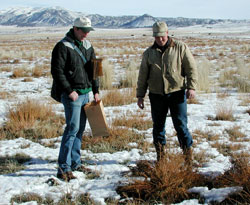Severe salinity affects more than just Nebraska. In fact, much of the soil across the Plains and Great Basin tests above 7.8 pH, creating difficult conditions in which to establish most forage species. At the same time, winter feeding costs on Intermountain West rangelands can reach as high as 50 to 70 percent of the total cost of raising a cow each year. Ken Olson, Dale ZoBell and their colleagues at Utah State University received a SARE grant to test saline-tolerant forage kochia as a winter feed in an effort to use saline soils more efficiently and extend the grazing season – a double bonus.

Saline-tolerant forage kochia fills a nutritious, palatable niche during winter, as Utah State researchers found in a SARE-funded study. Photo by Blair Waldron, USDA-ARS
Extending the grazing season into the fall could save $47-$90 per cow, according to their economic analysis. The limiting factor to extending the grazing season becomes nutrition; if a cow loses too much body condition, a dollar saved in the fall could cost as much as $2 to recoup in the spring. Grass loses protein and energy during its dormant season, but saline-tolerant perennial forage kochia retains nutrients during the fall and becomes more palatable – a characteristic that producers in Kazakhstan and Uzbekistan have realized for centuries.
SARE funded a November-through-January grazing test on former cheatgrass stands in Utah to answer questions about forage kochia’s ability to establish and contribute to cattle performance. While research is ongoing, findings thus far indicate that forage kochia not only grew on saline soils, but it also contributed to cattle weight gains when paired with crested wheatgrass. Moreover, the high moisture content of forage kochia means that it can act as an effective fire break, especially when compared to stands of dry cheatgrass. Perhaps most important, researchers found that producers seeding the shrubby forb could save about 10 percent on annual production costs.
“We expect producers to incorporate kochia into pastures that are used for winter grazing to improve the nutritional value in stands that are grass-based and therefore low quality when dormant during winter,” says Olson, now an extension beef specialist at South Dakota State University.
